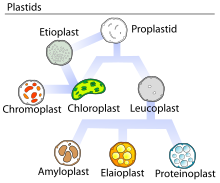Etioplast

Etioplasts are chloroplasts that have not been exposed to light. They are usually found in flowering plants (Angiosperms) grown in the dark. If a plant is kept out of light for several days, its normal chloroplasts will actually convert into etioplasts. Etioplasts lack active pigment and can technically be considered leucoplasts. High concentrations of etioplasts will cause leaves to appear yellow rather than green.[1]
These plant organelles contain prolamellar bodies, which are membrane aggregations of semi-crystalline lattices of branched tubules that carry the precursor pigment for chlorophyll. The prolamellar bodies are often (and presumed always) arranged in geometric patterns.[1]
They are converted to chloroplasts via the stimulation of chlorophyll synthesis by the plant hormone cytokinin soon after exposure to light. Thylakoids and grana arise from the prolamellar bodies during this process.
See also
References
- ^ a b Wise, Robert (2007). "1". The Diversity of Plastid Form and Function (PDF). Springer.
